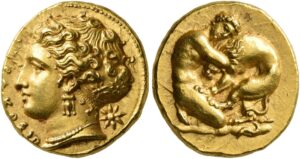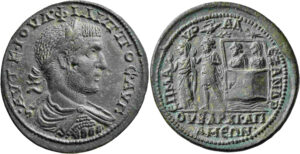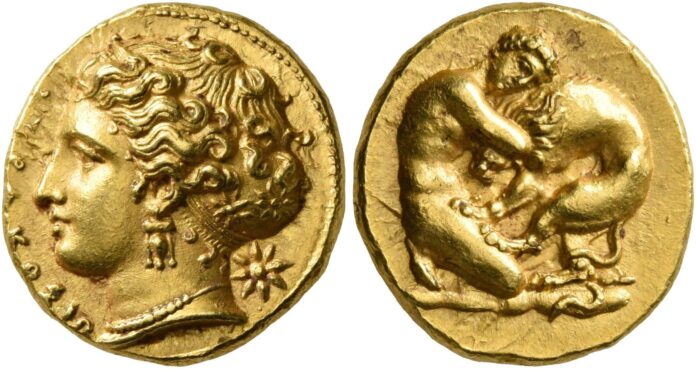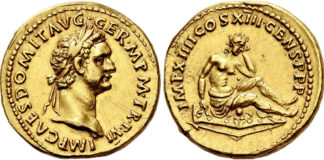Leu Numismatik: Kleinkunst Collection
Leu Numismatik offers two auctions that will be hold from 23 to 24 October 2020. Auction 6 contains the Kleinkunst Collection of highly important ancient Greek coins. Auction 7 is splitted in two parts and offers Celtic, Greek, Roman Provincial, Roman Republican and Roman Imperial as well as Byzantine, Medieval and Islamic coins.

Auction 6: Kleinkunst Collection
The “Kleinkunst” Collection has been assembled since the early 1980s, with the majority of pieces coming from the famous auctions of Sotheby’s in New York and London, Leu and Numismatica Ars Classica in Zurich, as well as Münzen & Medaillen AG in Basel. The coins share two commonalities: they are characterized by their exceptional qualities and have mostly excellent provenances. When one considers the number of pieces offered here which come from the most famous collections of the late 19th and 20th centuries, the significance of the “Kleinkunst” Collection becomes clear. Among the previous owners of many of the coins are renowned personalities and institutions such as de Guermantes, Viscount Wimborne (“Outstanding Collection”), A. D. Moretti, Nelson Bunker Hunt, J. P. Rosen, A. Trampitsch, Martine-Marie-Pol de Béhague (Countess of Béarn), C. Gillet (“Kunstfreund”), H. von Aulock, W. Niggeler, Comte Chandon de Briailles, R. C. Lockett, Barone Agostino Pennisi di Floristella, M. P. Vlasto, Viscount L. E. P. de Sartiges, Captain S. Mavrojani of Clyro Court, Herefordshire, R. Burrage, W. Lamb, L. Vierordt, M. Simon, O. Bloch, Osman Nouri Bey, Sir Hermann Weber, J. Wertheim, H. de Nanteuil de la Norville, C. S. Bement, the British Museum, Grand-Duc Alexandre Michailovitch, E. J. Seltman, P. Mathey, T. Prowe, J. P. Lambros, G. Philipsen, Prof. Carlo Stiavelli, Consul E. F. Weber, E. P. Warren, A. Rhousopoulos, R. Allatini, Baron Rothschild, H. Montagu, L. Naville, G. Locker Lampson, W. H. Woodward, R. Jameson, Sir Arthur Evans and the Dukes of Gotha, Duke Frederick II (1676-1732), and Count Anton Günther II of Schwarzburg-Sonderhausen-Arnstad (1653-1716).
Some provenances were already known to the collector upon purchasing the pieces from various auction houses. In many cases, however, Leu Numismatik’s meticulous research has brought to light even more extensive pedigrees. Due to their beauty, rarity and provenance, many of the coins from the “Kleinkunst” Collection have also been included in important monographs, scientific articles and exhibition catalogues. For example, no fewer than 46 of the coins on sale here come from the famous collection of A. D. Moretti, part of which was on loan to the “Antikenmuseum Basel und Sammlung Ludwig” and which, due to its “artistic ranking”, was published in the permanent exhibition catalog ”Greek Coins from Magna Graecia and Sicily”, edited in 1988 by Herbert A. Cahn, Leo Mildenberg, Roberto Russo and Hans Voegtli.

The current owner of the collection has always strived to acquire coins of good style and with aesthetically pleasing motifs. Thus, numerous pieces exhibit artistically designed heads, often in frontal view, as well as detailed depictions of animals, which constitute the charm and character of this magnificent collection. The selection and acquisition of the “Kleinkunstwerke” arose over many years from the fruitful exchange between the collector and his numismatic adviser, George Muller, who in the 1950s succeeded Leonard Forrer Sr. as managing director of the traditional London coin auction house Spink.

Auction 7
Due to the high number of consignments, Leu Numismatik have decided to present the 1,100 lots on offer in two catalogues and hold the auction over two consecutive days.
Part I of Leu Auction 7 opens with the Celtic coinage, including a significant series of gold and electrum coins of the Vindelici from a Swiss collection that was assembled over two generations, and the Eastern Celts from the collection of Harald J. from Lower Austria.
The task of selecting the Greek coins posed a special challenge in view of the excellent “Kleinkunst” Collection. However, Leu Numismatik have succeeded in compiling a selection of interesting coins that are in no way inferior to the pieces from the “Kleinkunst” Collection in terms of quality, rarity and provenance. These three aspects are exemplified by the gold decadrachm of Pyrrhos (lot 1135), which was consigned by an esteemed colleague. The piece comes from an old Swiss collection and came with a collector’s ticket, which indicated the origin of the coin from the collection of the famous and controversial writer Roger Peyrefitte (1907-2000). Leu Numismatik’s meticulous provenance research now revealed that the piece was not only from the collection of Theodor Prowe – sold by the Egger brothers in 1912 – but was also formerly part of the collection of the Royal Coin Cabinet in Berlin, which had acquired it from Dr. Friedrich Imhoof-Blumer (Winterthur), and was originally owned by Gustav Adolf von Rauch (1805-1877), the chamberlain and court marshal of Princess Luise of Prussia (1838-1923).

Further exciting stories await, especially regarding the outstanding Roman Provincial coins in this auction. In particular, Leu Numismatik would like to draw your attention to the cover piece, the magnificent large bronze coin of Philip I from Apameia from the von Aulock Collection with the depiction of Noah’s Ark on the reverse (lot 1457).
The coins of the Roman Republic and the Imperial Era make up the lion’s share of the second part of Leu Auction 7. Three collections are particularly noteworthy here: that of an Armenian businessman, a Bavarian enthusiast and a master chef who is a friend of Leu Numismatik. The coins from these collections are without a doubt among the most outstanding of this series of auctions and provide the opportunity for collectors with various financial means to acquire desirable pieces. Leu Numismatik also feel honored to be able to offer for sale the second, and highly significant, part of the collection of a retired senior air force officer. Over the course of around fifteen years, the collector has assembled more than 100 solidi from Constantine the Great to Anthemius from a wide range of mints and in outstanding condition – the result is spectacular! In addition to the common types in a condition hard to surpass, there are also large and seldom offered rarities of no lesser quality.
Gold coins are also a focal point of the second part of the “Aurum Barbarorum Collection” (lots 1857-1933). The 77 (sic!) pieces for sale here actually surpass even the first part of the collection in terms of quality and variety of types (Leu Auction 4, lots 783-833). This significant increase in number of pieces has enabled Leu Numismatik to successfully review and group this highly interesting early Germanic coinage on a scientific basis. An introduction can be found in the printed catalogue on page 188.
The Byzantine coins and lead seals deserve no less attention than the Roman coins. The highlight here is a small but excellent collection of Basilika of the Palaiologists, the last imperial dynasty of the Byzantine Empire, including the extremely rare 1/8th stavraton of the last Byzantine Emperor Constantine XI (lot 1980), only a few of which have survived. The two Byzantine seals of the Ekdikoi of Hagia Sophia and John Gabras are also of great historical importance (lots 1989 and 1990).
Finally, there is a compilation of Greek, Roman and Byzantine coin and commercial weights, which is unique in its abundance and quality. The showpiece of this group is the excellently preserved imperial market weight of Phocas (AD 602-610) from his 8th and thus last year of reign (lot 2059).
You can find all lots on the website of Leu Numismatik.
For further questions you can contact Leu Numismatik via E-Mail.




